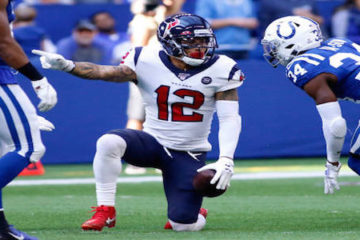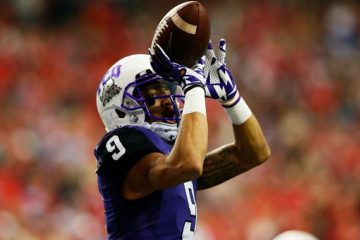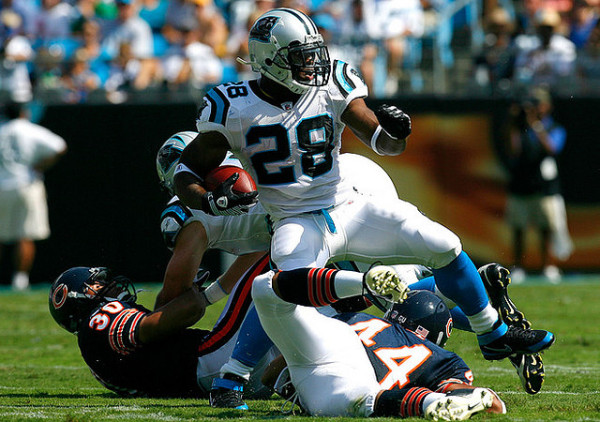2015 Fantasy Football: Wide Receiver Sleepers

Sleepers
All average draft position data comes from Fantasy Pros cumulative numbers.
Mike Wallace (WR30, 79th overall) – When you think of Wallace you may think he’s inconsistent simply because he was/is labeled as a deep threat and isn’t a possession receiver catching five balls a game. But that’s not true. In each of his last five seasons Wallace has caught between 60 and 73 passes, averaging 1,015 yards. Despite bad chemistry with his quarterback and coaches during his two-year stint in Miami, Wallace still caught 15 touchdowns in 32 games, and he caught a touchdown and/or gained at least 50 receiving yards in 13 out of 15 games last year (he was benched in Week 17).
Now he goes to a deep-threat-friendly Norv Turner-led offense where he’s the only proven wide receiver on the roster. Yeah, Charles Johnson ended 2014 on a seven-game stretch where he excelled…to the tune of 60 catches, five touchdowns and not even 1,000 yards over a 16-game pace. New quarterback Teddy Bridgewater, combined with the offensive system, should improve Wallace’s play and statistical output. This is a guy with four seasons of at least eight scores in a six-year career and just under an eight touchdown average season in his career. He should lead the Vikings in targets and yardage this season.
Eric Decker (WR42, 111 overall) – Decker led the Jets in catches (74), targets (115), yards (962) and touchdown catches (5) last year but lost his WR1 designation with the Jets’ trading for Brandon Marshall this offseason. Decker played well enough last year with Geno Smith quarterbacking, so whether Smith sees the majority of time this year or backup-turned-starter Ryan Fitzpatrick plays a lot, I think Decker will do just fine. Smith has shown some flashes of competent play in each of his two seasons, and Fitzpatrick has done just fine as a starter. Fitzpatrick has experience working with new offensive coordinator Chan Gailey, and regardless of who starts, the system should help Decker. The Jets don’t have any game-breaking running backs, so I think they’ll throw a lot this year. Decker’s shown he’s not just a “gritty” or “tough” football player; he’s a very good wide receiver who can be consistent and is capable of the big play. I think he catches 70 balls for 1,000 yards and six touchdowns, all at a minimum, this year.
John Brown (WR46, 124 overall) – Brown was part of a three-headed semi-monster last year in Arizona, finishing with 48 catches and 696 yards while being tied for the team lead in targets with 103. With such a balanced passing attack Brown’s upside is capped a bit, but he’s the most well-rounded out of himself, Michael Floyd and Larry Fitzgerald. Brown won in the short, intermediate and deep game last year, finishing eighth in average depth of target at 15.8 yards, according to Pro Football Focus. His 26 targets of 20 or more yards downfield tied him for 16th in the league, according to PFF, and he caught all nine catchable deep passes thrown to him in 2014. Floyd’s and Fitzgerald’s ADPs are 39 and 41, respectively, among receivers, but there’s no clear-cut reason to target them before Brown.
Davante Adams (WR48, 133 overall) – Adams finished third on the Packers in targets in his rookie year with 66, but the third receiver in the Green Bay offense still has a ton of value. In 2012 Jordy Nelson finished third on the team in yards and fourth in catches, but he had seven scores. In 2011 Packers’ receivers had touchdown totals of 15, nine, eight, seven and six. Twenty-thirteen was a lost year due to injuries to Aaron Rodgers and Randall Cobb, but hopefully you get the idea. In deep leagues Adams makes more sense than a WR2 on a poor offense. And if Nelson or Cobb misses a handful of games, Adams would be a top 20 receiver option in those weeks. Combine his skill and the offense he’s in, and there’s no reason not to select him as a reserve receiver.
Kenny Stills (WR58, 179 overall) – Stills is currently battling a calf injury so that’s something to monitor as the preseason progresses. But I’m surprised to see him this far down the wide receiver draft board. In his two seasons Stills is averaging 16.5 yards a catch – a number only five players topped last year – and his 2013 yards per catch of 20 is the second-best mark of the past two years. So you may think Stills is a one-dimensional deep threat, but, among players who played 50 percent of their teams’ snaps last year, Stills’ 79 percent catch rate was second in the NFL, according to PFF. Stills’ 12.8 average depth of target was the third-highest mark – behind only T.Y. Hilton and Emmanuel Sanders – in the catch rate top 30, according to PFF. Miami’s receiving corps was revamped this offseason, and its offense should be better this year – and Stills will be a big reason why.





